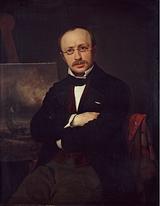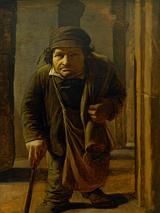European outsiders
Drama and impulses from abroad in Danish painting

Carl Bloch: 'Fishermen's families awaiting their return in an approaching storm. From the west coast of Jutland', 1858.
From the mid-1800s, the Danish art scene was dominated by two camps, one known as ‘the nationals’, the other as ‘the Europeans’. While ‘the nationals’ included the academy professor C.W. Eckersberg and his pupils, all of whom painted the Danish people, landscape and national past, the term ‘Europeans’ was used about a range of artists with a more international outlook. This group includes artists such as Anton Melbye, Ditlev Blunch, Lorenz Frølich, Anton Kieldrup, L.A. Schou, C.F. Sørensen, David Jacobsen, Otto Bache and Carl Bloch, several of whom lived abroad for large parts of their lives.
.jpg)
Ditlev Blunck, one of the ‘Europeans’, painted this portrait of marine painter Anton Melbye around 1852. Behind Melbye we see one of the dramatic marines that made him a star abroad, but which did not find favour among Danish art critics.
‘The brunets’ and Danish art criticism
Within art criticism, the ‘Europeans’ were also given the moniker ‘de brunette’ – the ‘brunets’, while ‘the nationals’ were called ‘the blonds’. The names point towards the colour schemes favoured by the two groups: those who took a national, Danish outlook would often use a bright, clear palette and paint their subjects by daylight, whereas the ‘Europeans’ would often employ rather more brown tones, partly inspired by French painting and by the instruction that several of them had received at the art academies of Düsseldorf and Munich. Several among the ‘Europeans’ depicted blushing sunsets and moonlit scenes; subjects familiar from German Romanticism. Their works were often based more on pure invention and imagination than on the close studies of nature favoured by Eckersberg and his pupils.
"Artists and art lovers are currently splitting up into two factions, or – as they themselves call each other – into two cliques […] and given that we speak of painters and parties both, we shall pick a couple of arbitrarily chosen colours to go with the party letters and call them the ‘blond’ and the ‘brunet’ cliques."
Written in Dagbladet, 1854.
The Danish art scene and Danish art criticism was influenced by the political movements and events of the time. This was a period where many were keenly interested in the question of what it means to be Danish. Artists with an international outlook did not fit into the nationalist-romantic project: they painted subjects from every corner of the world and let themselves be inspired by artistic movements from abroad. The art historian N.L. Høyen and art critic K.F. Wiborg were among the dominant voices of the time who did not care for the ‘Europeans’. Their reviews and texts have contributed to shaping our present-day outlook on Danish Golden Age art today, where ‘the nationals’ rather than ‘the Europeans’ take centre stage.
The Danish art scene and Danish art criticism was influenced by the political movements and events of the time. This was a period where many were keenly interested in the question of what it means to be Danish. Artists with an international outlook did not fit into the nationalist-romantic project: they painted subjects from every corner of the world and let themselves be inspired by artistic movements from abroad. The art historian N.L. Høyen and art critic K.F. Wiborg were among the dominant voices of the time who did not care for the ‘Europeans’. Their reviews and texts have contributed to shaping our present-day outlook on Danish Golden Age art today, where ‘the nationals’ rather than ‘the Europeans’ take centre stage.

Carl Bloch: 'Fishermen's families awaiting their return in an approaching storm. From the west coast of Jutland', 1858.
The battle of the ‘Europeans’ within the museum itself
The founder of the Hirschsprung Collection, the tobacco manufacturer and art collector Heinrich Hirschsprung, had a penchant for the well-travelled ‘Europeans’ and bought several works by these artists for his collection. By contrast, the first director of the museum, the young art historian Emil Hannover, favoured ‘the nationals’ and their narrative and so suggested that Hirschsprung should get rid of several of his purchases by ‘Europeans’. Among these we find Ditlev Blunck’s portrait of the marine painter Anton Melbye, which was, after Hirschsprung’s death in 1908, rediscovered in the attic of the family’s apartment in Bredgade. This is to say that Hirschsprung did not always take Hannover’s advice, and as a result the museum still owns a large collection of works by Danish artists with a more international outlook.

L.A. Schou’s 1866 painting of a dwarf dressed in rags shows us a rather different side of the Eternal City of Rome. Executed mainly in shades of brown, this painting is done with a realism that is far removed from the depictions of dancing Italians wearing colourful regional costumes popular among earlier artists.